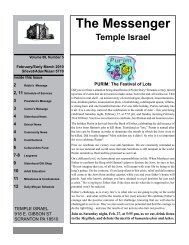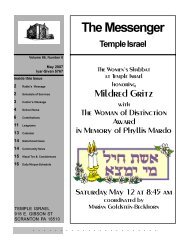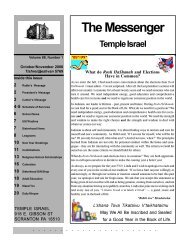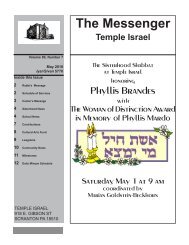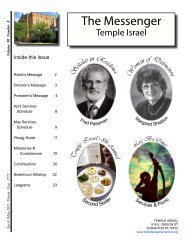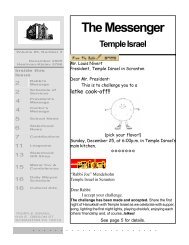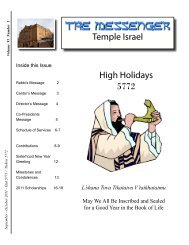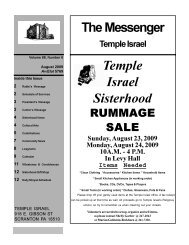Create successful ePaper yourself
Turn your PDF publications into a flip-book with our unique Google optimized e-Paper software.
September/October 2009<br />
In the early years of the 21st century, it has become<br />
clear to Hazzanim (cantors) and others<br />
involved in synagogue life that a new approach<br />
is needed if we are to keep services vibrant and<br />
meaningful for most Jews. In Conservative and<br />
Reform synagogues as well, the number of worshippers<br />
proficient in davening has diminished.<br />
<strong>The</strong> act of davening enables one to be actively<br />
involved in the service. Increased congregational<br />
singing has helped to fill this void.<br />
In our day, a growing number of younger generation<br />
families would rather spend their recreational<br />
time playing interactive sports or video<br />
games at the end of the work week than dedicating<br />
themselves to synagogue communal<br />
worship, and being actively engaged in the<br />
<strong>Temple</strong>’s life.<br />
In truth, a synagogue service must have a proper<br />
balance. To be sure, there must be an opportunity<br />
for participation. But, there also has to be<br />
points in the service when worshippers listen to<br />
the Hazzan, Rabbi and choir. Listening, too, is<br />
a form of prayer. It allows for inspiration to occur.<br />
Learning comes from reading, studying and<br />
listening to others.<br />
Rosh Hashanah and Yom Kippur are the days<br />
on which synagogues are filled to capacity. As<br />
Hazzanim our challenge is to touch worshippers.<br />
That task is made even more difficult because<br />
most who are in the synagogue on these<br />
days do not attend services regularly. What is<br />
our calling and responsibility as cantors I have<br />
always maintained that, in leading a service of<br />
liturgical prayer, we must create an aura of spirituality<br />
and closeness to God through cantorial<br />
chant. We must also engage our congregation<br />
to participate in prayer which ultimately brings<br />
feelings of unity, warmth and connection, bringing<br />
the worshippers back to their roots. Prayer<br />
and song is what draws one to spiritual heights.<br />
What could be more beautiful than seeing and<br />
hearing a synagogue filled with fellow Jews,<br />
families, friends and neighbors, joined together<br />
in harmony<br />
Continued on page 3<br />
China – A Lesson in Community<br />
China was a wonderful trip! Tienaman Square, walking the Great Wall, Yu Gardens,<br />
the <strong>Temple</strong> of Heaven, the zoo at Chong Qing, the Terra Cotta warriors, cruising<br />
up the Yangtze river… each site special, unique and precious. One element was<br />
common throughout our trip – a sea of humanity: rows and rows of 60 to 70-story<br />
high rises for Chinese people to live in, lots of cars, and millions of bicycles,<br />
electric bikes and scooters.<br />
One of the things special to me was observing how millions of people can live<br />
together – 18 million in Shanghai, 17 million in Beijing – over 5 million in tiny<br />
Chong Qing! Living space for most families consists of a living room, bathroom<br />
and one or two bedrooms, all small by our standards. <strong>The</strong>ir solution Community!<br />
People meet, play sports, discuss politics, play music, dance, exercise and relax<br />
in parks, at the zoo, in the green areas beside national sites – anywhere and<br />
everywhere. In Chong Qing, for the cost of one day’s admittance local residents<br />
get monthly passes to the zoo. In Xi’an there is exercise equipment to use in the<br />
parks by the city wall. Instead of packing the car, deciding what to take, what to<br />
eat and what to do in order to go to Nay Aug Park in Scranton or South Abington<br />
Park in Clarks Summit, residents walk to their local park, the same way we might<br />
walk across the street.<br />
While I would not want to live in such crowded conditions, I appreciate the value<br />
of community - the quintessence of Jewish values. Our J.C.C., as it celebrates its<br />
100 th anniversary, is centered around community, however community is not<br />
limited to the J.C.C. Community is <strong>Temple</strong> <strong>Israel</strong>’s daily minyan; community is<br />
our Reba and Art Douglass Religious School and community is family education;<br />
community is Friday night dinners; community is Shabbat and holiday services.<br />
Community is coming together to comfort and to celebrate.<br />
As we enter the year 5770, let us remember the words of Moshe as he said to<br />
Pharaoh, “lkb ubhbezcu ubhrgbc - We will all go, young and old.” We will all go into<br />
the next decade; I am here to help you as we journey together.<br />
As always, as we prepare for the year 5770, Linda and I wish to thank all of you<br />
for making each year special. I intentionally do not name names in order to avoid<br />
leaving anyone out. In the same vein, we apologize to each and every one of you<br />
in the words of our tradition: “If we have hurt anyone willingly or unknowingly,<br />
or through our actions or inaction caused someone to be hurt this past year, we<br />
apologize and ask for forgiveness. We ask that you accept this statement as<br />
being given of our own free will and as being genuine, coming from ourselves,<br />
and not from any situation forcing us to publicly state this. Linda also joins me in<br />
wishing each and every one of you, “L’shana Tovah u’m’tukah u’briah” — a<br />
good, sweet and healthy year in the book of life.<br />
“Rabbi Joe” Mendelsohn<br />
2 . . . . . . . . . . . . . . . . . . . . . . .



